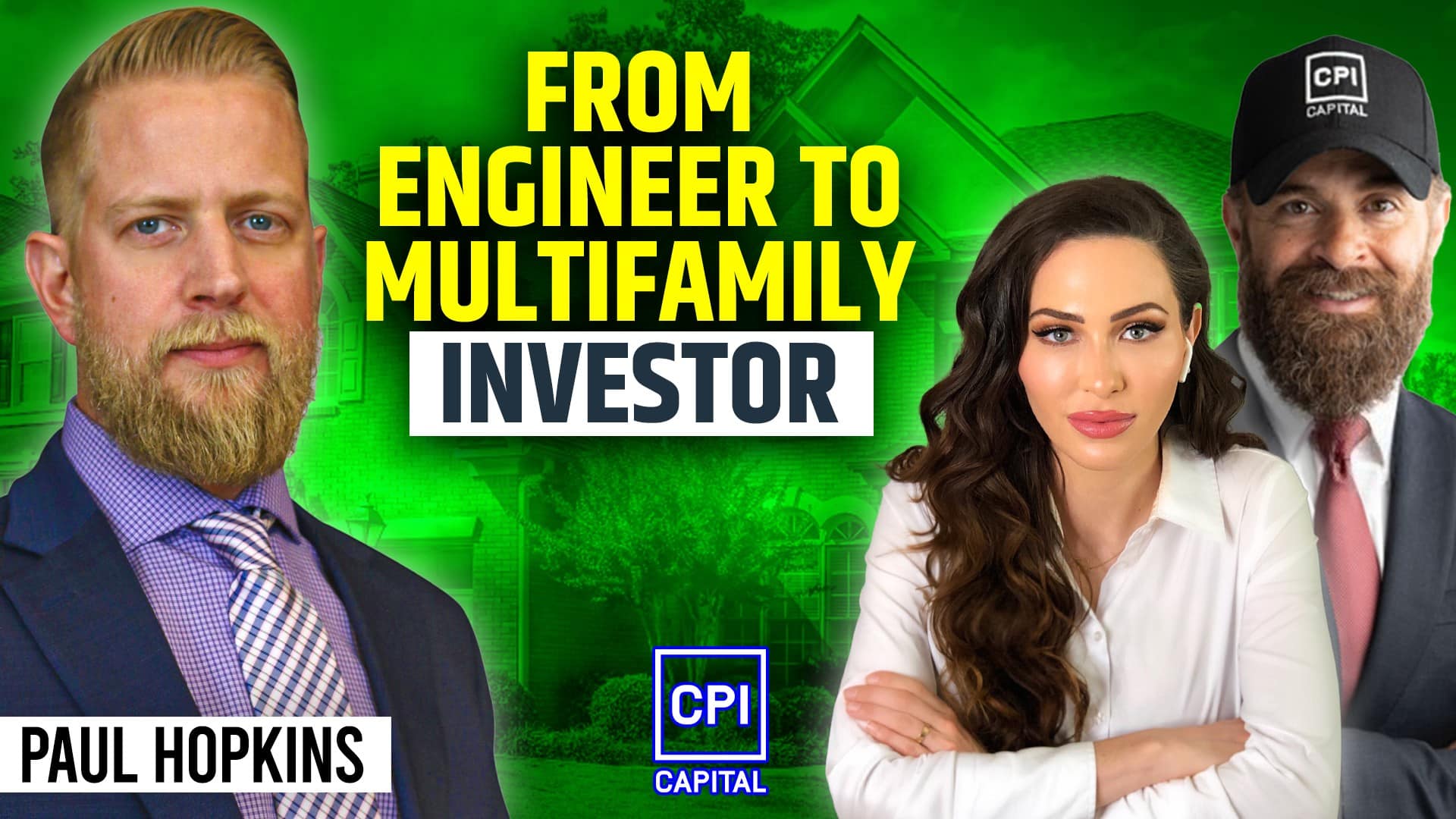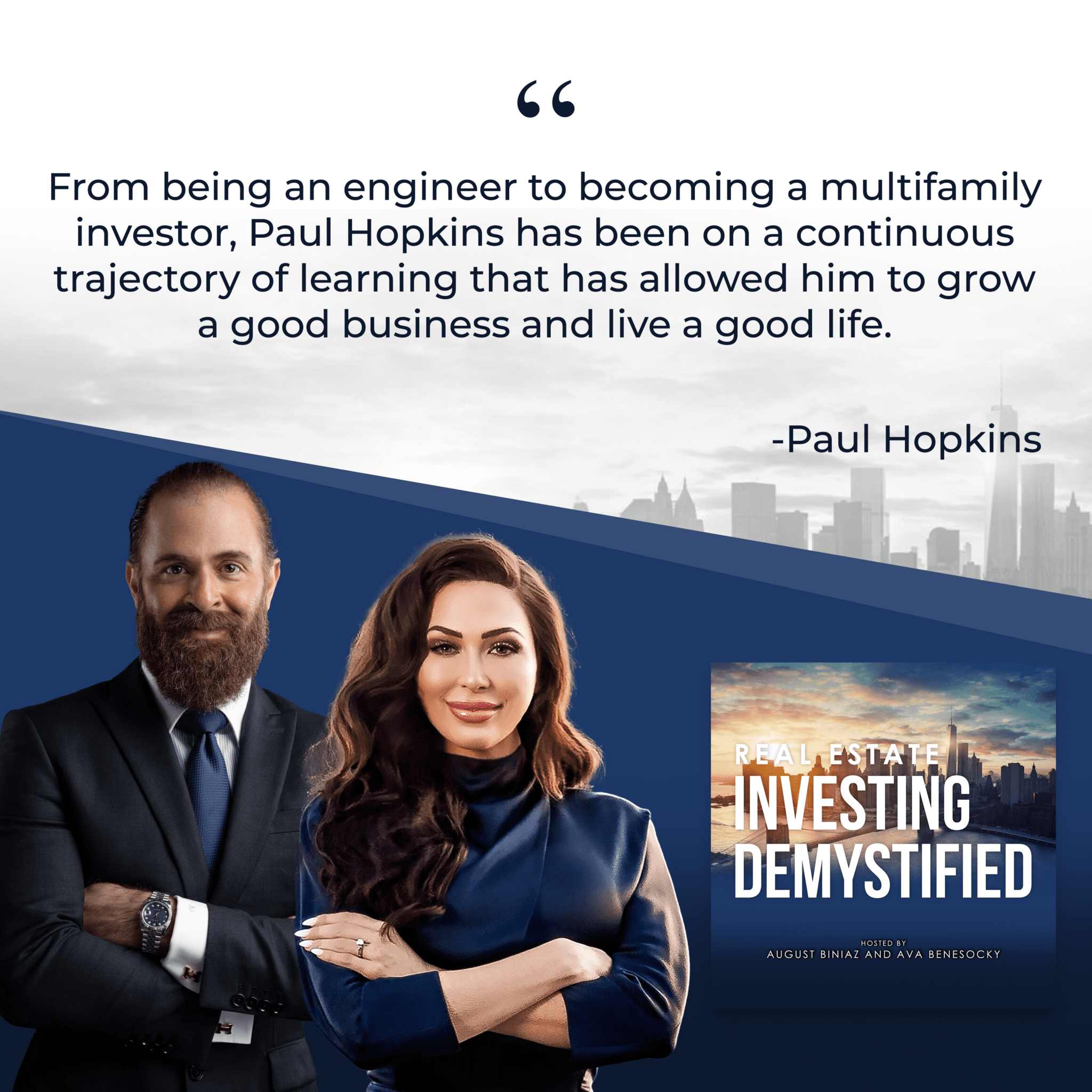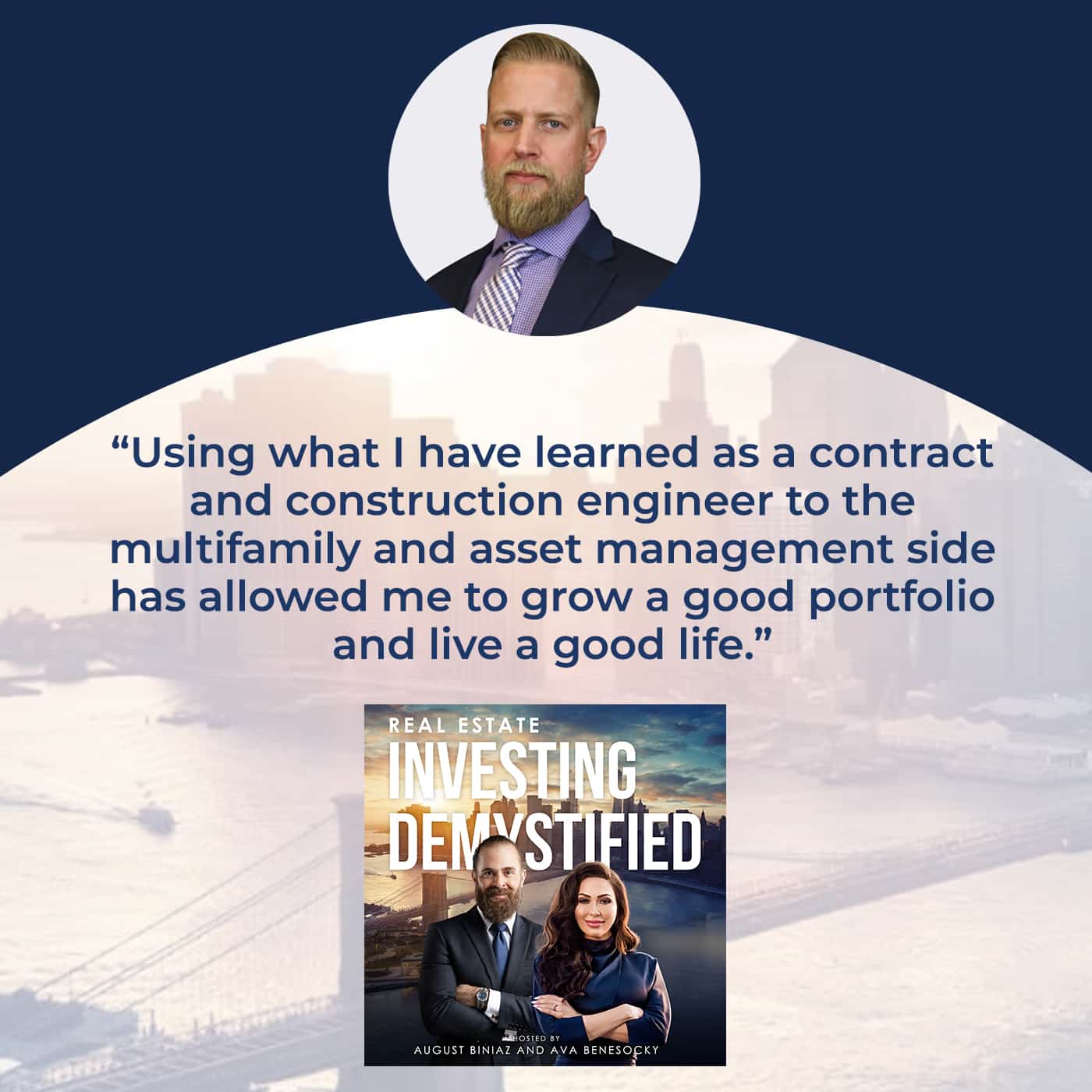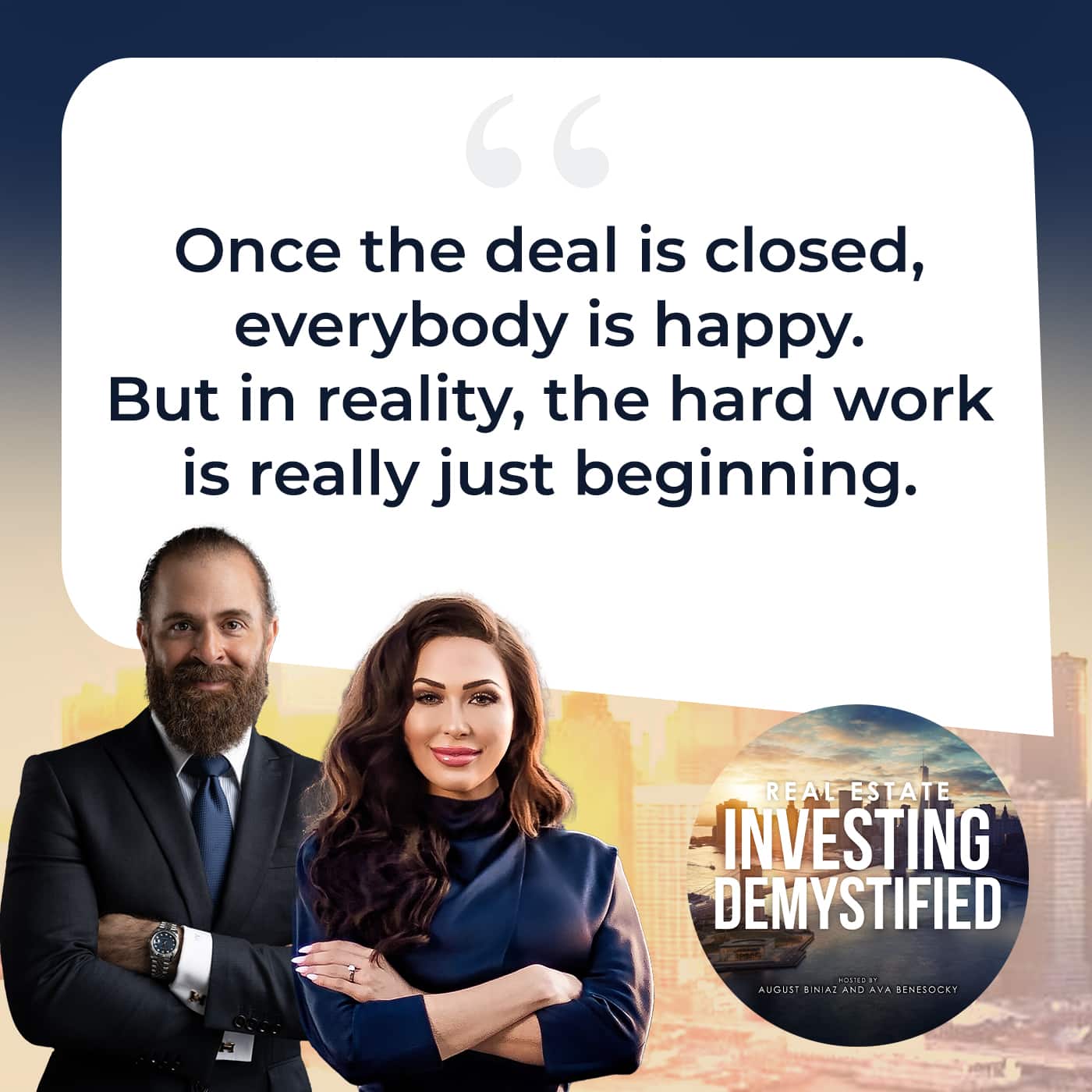It can be surprising sometimes how we can jump to seemingly different paths, only to realize how well-connected they were. To realize that the change you made all makes sense now. In this episode, Paul Hopkins, Director of Acquisitions for CPI Capital, shares his journey from engineer to multifamily investor. He shares how his experience in project scheduling, budgeting, vendor selection, and contractual relationships from his engineering background has translated seamlessly into his success in real estate acquisitions and asset management. In other words, his engineering background has helped him grasp the basics of investing and overall build a strong portfolio. Paul has managed multi-billion dollar infrastructure projects, overseeing various aspects of acquisition, underwriting, financial analysis, due diligence, and asset management. And today, he shares his valuable insights on the step-by-step process of acquisitions, asset management, and more. Tune in now and learn how different skills such as engineering skills can be leveraged in the world of real estate investing.
Get in touch with Paul Hopkins:
LinkedIn: https://www.linkedin.com/in/paulehopkins/
If you are interested in learning more about passively investing in multifamily and Build-to-Rent properties, click here to schedule a call with the CPI Capital Team or contact us at info@cpicapital.ca. If you like to Co-Syndicate and close on larger deals as a General Partner click here. You can read more about CPI Capital at https://www.cpicapital.ca/.
#avabenesocky #augustbiniaz #cpicapital
—
Watch the episode here
Listen to the podcast here
Important Links
About Paul Hopkins

Paul has 17+ years of experience in the construction industry and 7+ years in multifamily asset acquisition, repositioning and development.
Paul graduated with a Bachelors of Science in Engineering from Colorado School of Mines.
From Engineer To Multifamily Investor – Paul Hopkins
We’re excited to be here. We have a very special guest.
Our guests are very special but our guest is particularly special. We’re going to get into it because I’ve been on this journey of finding this person in our lives. It sounds romantic but I’ve been in the process of finding this person for a long time. It has been a good 2 and a half years or 3 years. I’m connecting with many others for this role within our company. We have been looking for an acquisition director or asset manager for CPI Capital. It has been an interesting journey, to say the least.
It has been a tough journey, to say the least. It’s not easy finding a good partner out there who you are going to trust your whole baby with. We found our guy.
This situation is a partnership. This is not an employee or a contractor. We are very excited. That was a big decision we had to make because we dedicated our lives over the last few years and even prior to that. The idea for CPI Capital started a few years ago but we spent the last few years of our lives both of us leaving our careers to build CPI and then bring on a partner.
It’s that missing puzzle piece. When the puzzle gets completed, do you know how good it feels? That’s what we feel.
Your family was in town. You were doing some puzzles on the dining room table there.
We finished it off. It was a difficult one. Work aside, everybody will learn about Paul Hopkins. On a personal level, he is such an amazing person. We have a lot of interests that we share like learning about longevity and how fasting can benefit us. He’s an amazing father and husband. It’s about the inner person as well. On the work side, he’s amazing.
Frankly, we’re so lucky to have met him and to be partnered with him. We’re excited. As you can tell, I’m sure our regular audiences know how excited we are because they know that this is an exciting time. Let’s get into it and talk about who Paul Hopkins is.
Let’s dive into who Paul is. Here we go. Here’s a little bit about his bio. Paul Hopkins is an experienced real estate professional with 17-plus years of experience in the construction industry and 7-plus years in multifamily asset acquisition, repositioning, and development. He consulted for a private equity real estate investment company performing all aspects of acquisition, underwriting, financial analysis, due diligence, and asset management.
Prior to his consulting work, Paul was an operations manager on a $2 billion infrastructure project in Canada. In this role, he managed engineers and contractors with respect to contractual relationships, vendor selection, budget estimating, forecasting, and project scheduling. Additionally, he was responsible for user coordination and overall project delivery.
Within his past roles, Paul has gained extensive knowledge in areas such as design-build projects and public-private partnerships. As part of these roles, he has assisted with the building of multibillion-dollar infrastructure projects while also handling the installation of signature bridge structures such as the Peace River Bridge, the Pattullo Bridge, and the Massey Tunnel replacement project.
Paul is responsible for sourcing, underwriting, and negotiating acquisitions across Sun Belt states as well as overseeing asset management for CPI Capital. We believe this interview with Paul will bring great value to passive investors looking to learn about the step-by-step process of acquisitions and asset management and to active investors looking to optimize their acquisition and asset management process. Welcome, Paul. We do a lot of talking.
Welcome, Paul.
Thank you. I’m honored to be here. I’m super grateful to both of you. I’m excited.
I used to build single-family homes for a long time. I know what goes into project managing a simple single-family home. When I connected with Paul a while ago, he was talking about building bridges. People trust their lives driving over bridges. We sometimes don’t even realize how much work there is and the intricacies that go into building bridges. Bringing that background and knowledge into our space, I was so excited to work with this grand partner.
It’s so impressive. Paul, can you start by please telling us about your background and your start in real estate?
I started working with my parents at the age of twelve on their fix and flips. At that time, I developed a passion for construction and understanding also real estate and how real estate can increase your wealth. I continued on the path of working as a laborer-carpenter in the field of construction all the way through high school. Even when I was working my summer job in college, I was always in construction. One of the reasons I became a civil engineer is that I’ve always wanted to build something big. I’ve always had a passion to build these massive projects.
When I was graduating college, I wanted to work for a developer but for whatever reason, I didn’t get the job at that time. I tripped upon an opportunity to work with a contractor that built bridges. During that time, I was working as an estimator. I’m learning how to estimate properly these massive projects, and then taking what I learned from the estimate, applying it to the project that we would win, taking that estimate into a budget, and managing a team to complete the bridge.
During that time when I was working for the bridge contractor, I was always still involved in real estate. I would live in every house that I would buy, fix it up, and sell it for a profit. That was tiring because I was working a full-time job, and then I would come home. I was flipping these houses all by myself. Around 2015, I realized it’s hard to do that. I got burnt out doing that so much, especially since I had a daughter that I was also taking care of. I realized that I needed to leverage my time a little bit more.
Around 2015, I quit my job working for this commercial contractor and went headfirst into real estate. I had an opportunity to work with a private equity firm out of Denver where we were acquiring multifamily assets. I’m learning everything that I’ve learned as a construction engineer and contractor, and applying it to the multifamily acquisition and asset management side.
I grew a good portfolio. I worked for that company for a couple of years, and then as time went on, I left that company for value reasons and continued doing fix and flips and real estate development. A few years ago, I wanted to get back into multifamily. I joined a mastermind group that was focused on multifamily and realized that if I wanted to do it big, I needed a team to surround myself with. That led me to meet you and have conversations. The rest is going to be history.
We appreciate that background.
Thanks for that, Paul. Let’s dive into things. What skills from your engineering and project management background have you been able to bring to the real estate private equity side, particularly in multifamily value-add?
When I worked on many of these projects, sometimes I would work on the estimating team before we ever got the project. I was putting a whole business plan in place. Most of the projects that I worked on were public-private partnerships, meaning that you assemble a design team and a contracting team with a banker. You’re all coming together to put an estimate together to build this massive project. To win the project, you would have this estimate that you would then have to turn into your budget and implement the business plan that was already set out.
While I was working as a contractor, I would be responsible for managing this budget, managing the schedule, and looking at where we had pluses and minuses due in forecasting so that at the end of the day, we knew exactly where we were going to be profit-wise in making sure that we’re pleading these projects on schedule. A lot of that translates into multifamily. You find a deal, underwrite it, analyze it, and come up with a business plan. Once that business plan is established, you’re also working with property managers, contractors, and lenders. You’re assembling a team to go after this single project.
Once that project is acquired, that’s when you execute the business plan as you do on a bridge-building project. From there, you make sure that you execute the business plan as you set out in your estimate. Your estimate might not be perfect but at least it’s a guide to what you need to do to execute that plan. You’re following that plan and making sure that you stay on budget. If you’re not on the budget, then what do you need to do to make some adjustments? At the end of the day, close the project out and collect the check. It’s a very similar process.
It takes a lot of organizational skills.
To say that Paul is organized is an understatement. Let’s keep going.
I want to get right into things. Project managers usually have their projects on a moving Gantt chart. Let’s walk through the step-by-step process of acquisition and then asset management.
Even when you’re putting an estimate together, you put your whole schedule together. There’s a timeline of what needs to happen.
I wanted to jump in. It probably starts first with sourcing the deal as an acquisition director. Give us some of your top deal-sourcing strategies and then walk us through them.
It helps to have a network. You’re building a network of people between brokers, lenders, insurance companies, and mastermind groups. You could also leverage people within the mastermind group that are in these specific markets that you have an interest in and that know their backyard much better than you would ever know. They’re able to walk assets for you and kick the dirt better than you can virtually. You leverage your network. You at least notify a bunch of people exactly what you’re looking for. Be very specific in that criteria. Deals start to come to you.
You’re working with brokers, other members of mastermind groups, lenders, and insurance companies. They have an idea of what you’re looking for. They start bringing deals to you as well. It also helps to have relationships with property management companies. The property managers are usually the first ones to find out that their owner is wanting to sell. It’s helpful to establish relationships with these property management companies. They can bring deals to you as well. That helps in building a giant funnel. All these properties are starting to come into this funnel, and then it’s a matter of quickly evaluating which one.

Multifamily: It’s helpful to establish relationships with property management companies. That helps build a giant funnel.
We will get into that in a quick moment but talk to us about differentiating between off-market deals and on-market deals. I’m writing an article about this as well. Talk to us about the pros and cons. You always hear a lot of times that sponsors have a deal. They’re promoting the deal, “There’s an off-market deal.” What’s so great about an off-market deal? Are on-market deals rendered useless?
I wouldn’t say that but you always want to try to get your hand in the deal first. When sellers are looking to sell a property, they usually engage a broker. It costs a lot of money to put together an underwriting package and an offering memorandum and send it out to the market. That takes a long time. It’s good to find a property off-market, which is usually coming from a broker or a property manager, or direct from the seller. To acquire those types of properties, you usually have to have a pretty good relationship with a broker, a property manager, or the seller themselves.
The reason they come to you is that they know you can execute and do it quickly. Once you see that a property is on the market, it has already gone through that process. It’s already dragged along for that seller. Maybe the seller is a little bit more patient. They want to see what the general market has to offer for this property. If you could get the property off the market in your hands before it goes out to the masses, you could probably get yourself a better deal.
By the time it’s on the market, now you’re competing with everybody else that’s out there that has access to the internet. You’re going to be probably paying a little bit more for that property. Unfortunately, for the seller, it’s going to take a little bit longer but they might get a bigger price in the end, whereas if you get it off the market, you can get a better price as long as you can execute quickly.
What advice do you have for a newer firm? Reputation is very important when it comes to deal flow. Brokers are not going to send deals to tire kickers as I was discussing on our call. How important is reputation? If it’s a newer firm or a smaller firm that hasn’t done a lot of deals in that particular market, how do you overcome that? How do you create optics to seem like a reputable team that’s going to close on deals to the broker so they can’t even take you seriously?
Every expert was once a beginner. You have to start somewhere. It’s developing these relationships with a broker and developing a reputation for looking at the deals, underwriting the deals, and giving feedback. It does take a little bit of time to nurture that but as long as you’re consistent, you get a deal from this broker, underwrite it, and give them feedback, “This is where my number needs to be.” That might not jive exactly with what the seller wants but at least you’re letting the broker know that you’re hungry, that you’ve got this desire for these properties, and that you’re taking it seriously.
If you do that enough times and be consistent with that, that’s when the broker might come to you and say, “You’ve lost out on probably 4 or 5 deals. I’ve got this other seller that might have a deal that fits the criteria that you’re looking for. Why don’t you take a swing at it? Let’s see what you can do with it before I put it out on the market.” It’s a matter of being consistent and always being engaged with this broker or seller.
Getting taken seriously in real estate is just a matter of being consistent and always being engaged with the broker or seller. Click To TweetYou have created a deal flow. The brokers are setting you up both on-market and off-market deals. How do you keep all this organized? Is there a back-of-the-napkin analysis you do to see if the deal even makes sense?
Here’s the best way I’ve done it, and I’m sure there are other ways of doing it. I have a property pipeline spreadsheet. I’ll add any deal that passes the initial sniff test to this property pipeline spreadsheet that lays out the different metrics. What’s the cap rate? What’s the selling price or the whisper price? What’s the NOI in place? From that, we’re able to do a quick analysis. We call it the back-of-the-napkin analysis. It’s a ten-minute overview seeing where the market expense ratio is, what the year’s expenses are in place, and what they need to be.
You can see the potential rent growth based on the NOI, the market cap rate, and where you think the NOI can get to. If you’re within 10% to 15% of the whisper price, then it’s worth digging into a little bit more. It has to pass that initial sniff test to see if you’re within the expected sell price that the seller is looking to do. If you’re way out the lunch, don’t even bother. Tell the broker, “My number is not going to even be close to what you’re expecting. With all due respect, I’m going to bow out of this one to the next one.” Once it passes that, then you could dive deeper into the analysis.
We will get into that in a quick moment. We have been in an interesting type of interest rate environment. The Fed has increased interest rates faster than they have ever done in history at least 500 basis points in a matter of less than a year. How does that factor into your underwriting? Do you source debt while you’re underwriting deals? Do you have conversations with debt brokers already about to see what your rates are? Maybe you can touch on this metric of going-in cap rate and the current interest rate you could get deals at. Talk to us quickly about debt and how it relates to your initial underwriting.
It’s all about establishing your team ahead of time and working with lenders that are seeing what the market is doing in a day-to-day or hour-to-hour thing. In my experience, there are some brokers or lenders that I work with. As soon as I get a deal, I’ll pass it over to them and say, “What do you think this property is worth? What do you think we can get for lending? Is it worth looking at bridge loans? Is worth looking at permanent financing? Are there any other strategies that we could come up with that fit a good model for this particular property?”
It’s engaging brokers and lenders right off the bat. They’re part of your team because they want to do these deals successfully too. They have a vested interest. I always reach out to them if there’s a property that has passed the sniff test and the napkin underwriting. We get these guys involved, and then they can give us some guidance, “Here’s where we think you might be in 30 days from now.”
If you submit an offer, you need to forecast what the market is doing. Nobody knows. Nobody has that crystal ball, unfortunately. You have to project, “If interest rates do climb up, what does my model look like?” You have to stress that as well during that time but it’s a matter of having these conversations with a lender and getting them to give you feedback on where the market is going and how the financing might look, your loan-to-value or your debt service coverage ratio, and what those minimums are going to be. You build that model.
Let’s talk about the next step now. You have that deal that passed the initial sniff test. Walk us through the detailed underwriting, please. First, what is the information you need to conduct detailed underwriting, and who provides this info to you?
On a high level, we have looked at deals together. It’s all those different tabs and numbers. We could talk about underwriting. It passes the initial sniff test. You talked about getting involved with other stakeholders such as your debt brokers but when you’re putting those numbers into your underwriting model, which is very sophisticated, what is the information you need? Where does that information come from? Talk to us on a high level about the process of underwriting a deal or the full analysis that you do.
The most important thing that you do need is first of all the current rent roll and the T12. Once you have that information, you can see what the history of this property is looking like, and then you’re able to forecast, “If your rents are currently at this but your market is saying that it needs to be a little bit higher, that’s the information you need.” You need the rent roll and the T12. That usually comes from the broker or directly from the seller.

Multifamily: The most important things that you do need is, first of all, the current rent roll and the T12.
The next thing that I typically look for is crime statistics. I do some research on the area. There are certain websites that I use to see what crime looks like in the area to make sure that we’re not in the war zone or on the edge of where something might be happening or migrating, or the demographics are shifting. It’s always important to look at that. The next thing I get is some guidance from my lender on what the loan-to-value or the debt service coverage ratio might be and where interest rates might be. I’m taking that information. That comes from the lender.
I talk to insurance. I’ve learned in the past that insurance takes the longest to get the proper information. You want to reach out to an insurance broker right away to see your typical insurance rates for that property in that market. Does that market have a history of natural events like hurricanes, flooding, and things like that? They look at that from another point of view to make sure that if it’s in a danger zone, your insurance rates are going to go through the roof. It’s important to get that number too.
Those are the items that I first look for, at least from third-party sources. One last thing that is super crucial is to get some data. Typically, we get it from CoStar. There are other programs out there but CoStar does a good job of showing the demographics of the market, the property specifics, some of the history with the property, the rent growth, vacancies, occupancies, and other rent comparables and sale comparables. You’re collecting all that data to see what the trends are in that particular market and how you can apply that to this property. Those are the items that are the most important.
For some of our audience who can’t visualize an underwriting model, you’re inserting all of this information into a very sophisticated Excel model, and you’re looking to get some numbers out. This is not only if the deal makes sense as far as the equity and the debt but you’re also dealing with investors’ capital and the profit share with those investors. That’s an important component of an underwriting model as well. Initially, you have to see where your equity is coming from. If it’s coming from LP investors, what is the profit share? What is the promote? What are the fees being charged? Do all those factors get added to the model as well?
What you want to get to is your net operating income. Once you get your operating income, then you could start structuring your debt. Now that you got your debt coverage taken care of, what’s remaining out of the potential cashflow? From there, you’re able to say, “I could carve out X amount of dollars to our limited partners or equity.” After all that has been paid out, then you’re left with the cashflow toward the general partnership. Figure out the rent and the expenses to calculate your NOI. Make sure your debt coverage is paid for. With whatever is left out, you make sure that you carve out the right percentages for your team and partners.
Can you talk to us about some of the red flags while underwriting, for example, if the medium household income in the area is super low?
You want to make sure that you check out the average household income in that area and if the tenants have the ability to afford the rent. If the rent is $1,000 a month, they need to be making three times that per month to afford that place. Your property manager should be screening these tenants to make sure they have affordability. You do check the affordability of that area and that market. If your household income is too low, that means that your rents are going to be low for that area too. You want them pretty high on average.
I had another thought of what to look out for. Crime is an area that you want to keep an eye on. For insurance, we were looking at a deal in Houston that happened to be in one of the worst locations in Houston for insurance costs. My initial estimate on the insurance was three times less than what it should have been. It shows, “This is a red flag.” That’s another thing that you need to look out for.
You want to make sure that you got a good diverse economy, not just a one-trick pony. We were looking at Colorado Springs, for example. Colorado Springs is known to have a good presence of military but if it was just the military, I would probably pass on that deal or that market because you never know what’s going to happen with war or things happening with the government. You got a mass exodus of people that might happen. If you got a military town, you want to make sure that at least it has supporting industries and lots of private companies. Maybe they get government contracts, technology, healthcare, and education. You want to make sure that it’s a diverse economy as well.
Those are great red flags. Thanks for sharing that. You sourced the deal. You’ve cherry-picked the best deals. You’ve underwritten the top deals. What’s next? Talk to us on a high level about LOI and PSA. What’s the difference? How long does the stage take? Who are the people that get involved in this?
By the time you to the LOI stage, the Letter of Intent, it is telling the broker and the seller, “This is what I’m willing to offer on this property and my terms.” It’s not a contract obligation at this time but it’s letting them know, “This is what we intend.” If the property is on the market, there’s a call-for-offer date that you normally submit your offer.
Sometimes there’s another round known as best and final. They have probably 15 to 20 different groups that submitted an offer. They select the best five groups and then say, “You made it to the top five. Please give us your best offer.” You get another chance to sharpen your pencil a little bit more, seeing what you could get. What I always do is pretty much say, “My number was my number. I can’t sharpen that pencil anymore.” I would rather not go over too much on my offer price.
Let’s say you do win the deal. Your offer and letter of intent were accepted. You have 10 to 30 days to put together a purchase and sale agreement. Before the LOI is submitted, you want to make sure that you have at least your lender, a property manager that you’ve been talking to, and an insurance guy on board as third-party groups.

Multifamily: Before the LOI is submitted, you want to make sure that you have at least your lender, a property manager kind of that you’ve been talking to, and an insurance guy on board.
Once you get into an offer that’s accepted and you have your purchase and sale agreement, that’s when you get your attorney involved. You need to have an attorney that’s going to either write up this purchase and sale agreement or review it for you, making sure that you’re protecting yourself from any other issues. You’re also identifying the terms or the length of time that you need for due diligence, lending, approvals, or anything else that might be coming up during this time.
It takes typically 10 to 30 days to negotiate that and sign that agreement. Once you have that agreement signed, you have 30 to 45 days depending on what you need for due diligence. That’s when you’re going to the property, inspecting all the units, and walking through each unit with a contractor and the property manager. You’re bringing other contractors to the property to inspect the roof and sewers and get a deep dive into the overall health of the building and the structure.
You’re bringing the property manager there to look at the lease audits. We’ve got a full-on 300-item document for due diligence of all the things that we need to check for, go through, and make sure that we looked at. That takes 30 to 45 days. Once you’re at 30 to 45 days, the due diligence period has ended. You then have another 30 days to close.
This time, your lender and insurance guys are still working with you. The property manager is also working with you and putting all these puzzle pieces in place to make sure that your underwriting is still good and valid. Your lender is working toward qualifying the sponsor for the loan, presenting the deal to the different banks, Freddie Mac, or Fannie Mae, and getting their approval.
That’s 30 days after the due diligence. That’s when you typically close. You want to also put an opportunity to extend the contract if you needed to if something came up, your lender needs a little bit more time, we need a little bit more time to raise capital or something like that. At least you have the option to extend it another 30 days.
For me to interject, you talk about raising capital. All these items that Paul is talking about are a parallel line also with raising capital. Paul is conducting all of those steps on the acquisition side. Ava and I are running the investor relations, creating the marketing materials, sending that to investors, getting everybody ready, talking to legal, and getting those security documents ready for the next step.
It’s a partnership agreement.
It’s a team effort here to us working together. Keep going. Ava wanted to quickly say something as well.
In reality for new syndicators or even investors, how many deals do you have to underwrite and submit offers on to then get a deal?
You’re underwriting a lot. We’re looking at a lot of properties. You have to use your time wisely. A lot of deals are not going to pencil out. The more you do this, the more you see, “This is a good deal. This has potential. This seller is way out to lunch.” It’s looking at a lot of deals before you get down to the one that makes sense. You’re also competing with other guys in the market, especially the bond market. You have to compete with them and go through that length of time. During that time when you’re in that LOI stage, you’re now focused on that one deal. You don’t want to be doing too many other deals at that time because your priority is getting that one done. There’s a lot of work to happen between soon as the LOI is accepted and you close. We’re all working in parallel to make this happen.
It’s a lot of work. Let’s say, “The deal is closed. Everybody is happy,” but in reality, the hard work is beginning. You don’t need to create a business plan. I’m guessing there is a business plan built ahead of time but most commonly, what are the first steps taken when a multifamily value-add property is acquired?
For our audiences who might not be familiar with value-add, it is where you purchase an already existing multifamily asset. It’s already stabilized. Your business plan is to go in there and increase the value by doing some small renovations and increasing the occupancy. That’s what multifamily value-add describes. When you finally close on a multifamily value-add deal, what’s the first thing you do? There’s a lot of stuff to be done. What’s the first thing that takes place? Walk us through the process of taking over the property.
Before you close, you want to make sure that you have your business plan all done and sat down with your property manager because your property manager and contractor are the two major things that can change the outcome of the deal. You want to make sure that they’re on board with your business plan before you even close. Everybody is aware of what the business plan is. They’re on board with it. They’re ready to execute it. On the day that you close, you want that property manager already there making the changes that you’re looking to do.
On day one, you got your property manager on-site making introductions to all the tenants and letting them know that there’s a change of ownership. We’re there to improve the quality of their life. We’re there to help them feel safe and secure in this new ownership. There will be some changes. There are going to be some renovations and things coming up but that’s day one. You get in the ground and start making those changes.
Your contractor is the other important team that you want to have on board even before you close. You have the timeline already set aside. We’re going to close in the next 30. You start negotiating with your contractor to get them prepared to hit the ground running almost on day one. You want to give yourself a little bit of buffer at least to make sure that the property manager has a good handle on the asset and that their business plan is getting ready to execute it.
Within 30 days, you want to make sure that your contractor is there on-site with materials already pre-ordered. When there are vacancies, you jump on those vacant units right away to start the renovation. That’s the ideal situation. Sometimes it doesn’t always work out that way but you want all these people lined up and ready to execute their business plan on the day of closing.
Notify the tenants. Have your contractor and property manager ready. Start turning units right away. Start the renovation process as soon as you take over the property. This is exterior and interior upgrades right away. Here’s a question for you. We have been in a hyper type of market where prices have gone up and rents have gone up. It has been the gravy train.
Some sponsors would purchase properties and wouldn’t even do any value-add because the rents were increasing so much. The loss to lease was so great that they didn’t even need to do the value-add. What is your prediction of what’s happening with the market? In some areas, the rents are dropping. In some areas, rents are flat. How important is value-add? Is value-add still a feasible process if rents are not increasing? Does that all depend on the loss to lease? Give us a quick thesis on this.
My thought is that you always want to improve the property. You want to make it attractive for people to move into the property. There’s lots of development happening in different markets. There’s going to be an availability of brand-new properties on the market.
In real estate, you always want to improve the property and make it attractive for people to move into the property. Click To TweetA million units are coming to the market nationwide over here.
They’re going to absorb a lot of tenants and the market. You are going to see some vacancies among all the other multifamily assets. If you aren’t proactive at adding value to the property and making it look attractive to your tenants, they’re going to move out. They’re going to look for another place that’s better. Now you’re dealing with a problem of high vacancy and then your NOI is going to drop. You want to do your best to retain those tenants. You always build it into the business plan that you’re going to be renovating the exterior and the interior. It’s always best to execute that.
Throughout the life of the project that you own, if you see that things aren’t happening that way and that you could probably trim down on some of the costs of construction and things like that, and if you’re able to increase your rents without doing Class A type of renovations, stay with that. Adapt and change to what the market is telling you. You always want to be prepared to make those renovations happen because you’ve got a lot of competition that’s brand new on the market and a lot sexier than a property that was built in the 1980s. It probably has a lot more amenities too.
There are a couple of more questions before we get to the next segment of our show. Thank you so much for giving us so much wealth of knowledge. Let’s talk about this rent increase. We’re both based in Canada. Our investments are only in the US. We only invest in certain states within the US where there are landlord-friendly laws. The reality has checked in. If you don’t pay your rent, you get kicked out. There are no real rent control laws in place. Free market capitalism wins. If you don’t take care of your tenants and if your rents are not reasonable numbers, you lose them to another property.
It’s free market capitalism but aside from the concept of rent control, when you talk about increasing rent, let’s walk through the process. We buy a 100-unit apartment building. It’s 90% occupied. You have ten units that are vacant. We go in there, renovate those units close to where we have taken position, and do some outside renovations as well. The asset is better now. The question is this. What happens with those ten units? Is the process to offer them to the existing tenants for a premium? If the rents are $1,000, do you offer those at $1,200? Do you market it? Is it something you work with a property manager? Talk to us about the foundation of value-add if you may.
A lot of it probably has to do with the tenants that are already there on that property. If you’re doing a heavy value-add, a lot of those tenants might be comfortable in addition to the property that you have. Maybe you don’t want some of those tenants. The previous property manager may have not screened the tenants’ property to verify income and other sex offenders or other red flags of things that you want to keep away from your property. Even though you have these ten vacant units available that you could renovate, it depends on the current demographics of your tenant base to make sure you want them to stay. That’s something that you have to consider.
You will find that out during your due diligence when you do lease audits, and you’re walking through each one of these units. You might identify which ones are bad tenants. You want to try to force them out if you can. One of the important things is you need to focus on the curb appeal first before you dive too deep into renovating all these units because you want to show the rest of the tenant base that you’re adding value overall. You want the place to look good. You want them to feel good about living there.
The exterior of your property needs to look like the curb appeal. You need to focus on that first before you really dive too deep into renovating all these units. Click To TweetIf you can justify to them, “We have done all the roofs. We have painted all exterior. We filled up the pool that has been sitting empty for the last couple of years. We’re making these changes,” and when they see those changes, they see that the value is there and that you are improving this property. That is a way for us to justify a potential increase in the rents without renovating too much as well. When their lease comes up, bring these up to the market. You can do it in two ways. You can renovate the units and move them over or bring in new qualified tenants and increase the exterior value or curb appeal. You’re able to increase the rents of the existing tenants as well based on that.
Here’s the last question. A lot of times, I talk to investors, partners, and even some of my friends. I talk about that. We are in real estate. We buy real estate assets but we’re buying a business. Institutional multifamily assets behave like a business because we buy them on the basis of the income it produces. It’s managed like a business, and a business has a brand.
We were in Florida in Naples. We drove by a couple of these nice apartment communities that look nice from the outside. They have a brand. I googled it. They have Google reviews. How important is the brand associated with an asset? How important is it to optimize and make that brand better when we take over? Is that something completely in the hands of the property management firm rehandle? Do we get involved in the whole process of branding?
Branding is key. You want to develop a reputation. If tenants find out who the owner is or what the property management company is, they’re going to do the reviews. They want to see how this property manager treats their tenants or how the owners treat their tenants. You want to make sure that you do get the branding taken care of. You could even work with a marketing or branding expert to come up with attractive names and something that is unique to the area or what we’re building here in keeping things consistent, coming up with that name, and rebranding the whole property.
Sometimes the property itself has a bad name and a bad reputation. You want to cut that away. You want to get rid of that and bring in a brand-new name. Maybe change the color scheme or at least keep the color scheme of properties that are consistent. Once you have that, tenants realize, “They have this property.” They could identify that it’s all owned by the same company and managed by the same property manager in that area. They know that you’re going to have a good product. They’re going to treat your tenants right. You’re going to attract more that way. It is important to have your branding in place.
Thanks so much. We appreciate it.
Paul is a wealth of knowledge.
To people who have stayed tuned this far, we are starting a regularly set webinar that’s going to be hosted by Paul where he’s going to be talking about these things in much more detail. He’s going to bring out other experts as well. Watch out for that in our email. Subscribe to our newsletter. You will be updated on when those webinars will start. They’re going to be great. Let’s get to the next segment of our show.
Here we go, Paul. It’s the Ten Championship Rounds to Financial Freedom. It’s whatever comes to mind. I’m going to ask you ten questions. Let’s do it. First question, who has been the most influential person in your life?
Collectively, it’s my family. They have always pushed me to go above average. They’re always instilling the proper values into my life and teaching me about discipline and hard work.
That’s your immediate family and parents.
It’s my parents, my brother, and my wife. I’ve been looking at my daughter too and making sure that I’m a proper role model for her.
Next question, what is the number one book you would recommend?
It doesn’t have to be a real estate investing book. It’s any book for whatever reason.
Becoming Supernatural by Dr. Joe Dispenza.
I love Dr. Joe Dispenza. We share a lot of the same interests.
You can see that this book is beaten up. I’ve read this book several times. I’ve listened to the Audiobook several times. That book gave me a complete paradigm shift of reality, my life, and everything. I highly recommend that book to anybody.
If you had the opportunity to travel back in time, what advice would you give your younger self?
Start earlier and be patient.
Next question, what’s the best investment you’ve ever made?
In myself.
What’s the worst investment you ever made? What lessons did you learn from it?
When I first started understanding commercial investing and syndication, I invested as an LP with a group that I wish I didn’t. It had all the red flags. Looking back now, I don’t know what I was thinking but I trusted this person. They were a guru. They had their education platform and things like that. They’re not around anymore so I’m not going to say who the name was. I invested with them. Everything about it was wrong. The paperwork, the business plan, and how it was executed were all wrong.
I learned a lot of good lessons from that. Do your due diligence on the person and the business plan. Hire a lawyer to look at the paperwork and make sure that you know what you’re looking at because you don’t know what you don’t know. I was getting into it. It looked attractive. I trusted this person but in the end, it was a complete failure.
It can be overwhelming. It’s a 200-page document that you’re signing off on. There are so many different things.
Was it a total loss, Paul?
Yep. It was a good education. I invested in a good education.
There you go. Next question, how much would you need in the bank to retire now? What’s your number?
The money in the bank isn’t the most important thing. It’s cashflow. It doesn’t matter how much I have in the bank as long as I have enough cashflow. Here’s the net worth and cashflow that I need. I’ve always had the number of a net worth of $10 million. Whether you want to say that’s in the bank or assets, that’s what I’m looking for.
If you could have dinner with someone dead or alive, who would it be?
I would have to say Marcus Aurelius. I study Stoicism. He’s probably one of the greats of the Stoics. It would be great to be around in his presence. It’s Marcus Aurelius for somebody dead. For somebody alive, it’s Tom Bilyeu of Impact Theory.
Maybe you will get on the show one day.
That would be awesome.
That’s a good one. Next question, if you weren’t doing what you’re doing, what would you be doing now?
Probably traveling the world. Snowboarding would be one. It’s traveling and snowboarding the world.
We’re still going to be doing that.
August will be right beside you.
We already snowboarded and skied together in Whistler. He’s a very good snowboarder. Let’s keep going.
Here’s my favorite question. Book smarts or street smarts?
Street smarts.
We love that. Here’s the last question. If you had $1 million in cash and you had to make one investment now, what would it be?
I would probably invest in a mastermind group and surround myself with people that can make that money grow tenfold.
It’s all about who you surround yourself with.
I have to be honest. That’s one of the best answers to most of these questions. You would think that he had a cheat sheet. He was so good. It was excellent. Thank you so much. We appreciate it. Maybe you can quickly tell people how they can reach out to you if there are brokers out there with a lot of off-market deals.
You can reach out to me by my email now. It’s Paul@CPICapital.ca.
If anybody wants to connect with Paul on LinkedIn, it’s Paul Hopkins. You can check him out on our website, which is www.CPICapital.ca. This has been amazing, Paul. We’re so happy to have you here.
Thank you so much. I’m so grateful.






